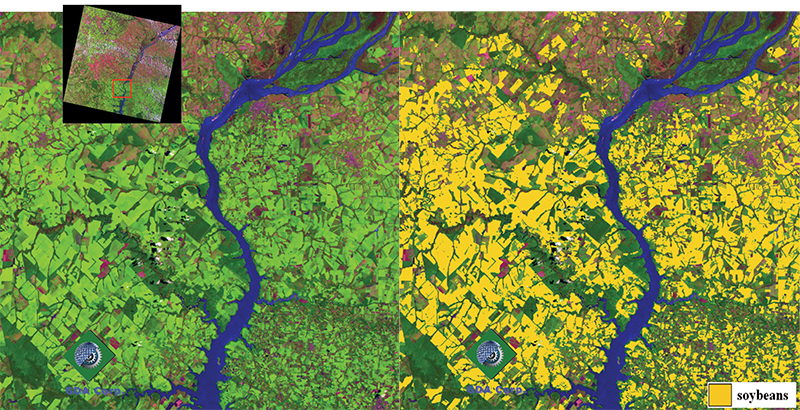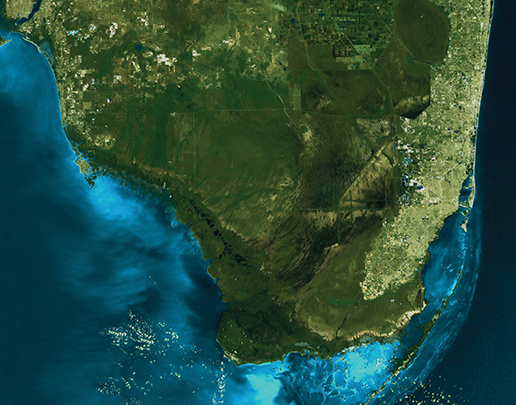
Feature Detection Systems Enhance Satellite Imagery
Originating Technology/NASA Contribution
In 1963, during the ninth orbit of the Faith 7 capsule, astronaut Gordon Cooper skipped his nap and took some photos of the Earth below using a Hasselblad camera. The sole flier on the Mercury-Atlas 9 mission, Cooper took 24 photos—never-before-seen images including the Tibetan plateau, the crinkled heights of the Himalayas, and the jagged coast of Burma. From his lofty perch over 100 miles above the Earth, Cooper noted villages, roads, rivers, and even, on occasion, individual houses.
In 1965, encouraged by the effectiveness of NASA’s orbital photography experiments during the Mercury and subsequent Gemini manned space flight missions, U.S. Geological Survey (USGS) director William Pecora put forward a plan for a remote sensing satellite program that would collect information about the planet never before attainable. By 1972, NASA had built and launched Landsat 1, the first in a series of Landsat sensors that have combined to provide the longest continuous collection of space-based Earth imagery. The archived Landsat data—37 years worth and counting—has provided a vast library of information allowing not only the extensive mapping of Earth’s surface but also the study of its environmental changes, from receding glaciers and tropical deforestation to urban growth and crop harvests. Developed and launched by NASA with data collection operated at various times by the Agency, the National Oceanic and Atmospheric Administration (NOAA), Earth Observation Satellite Company (EOSAT, a private sector partnership that became Space Imaging Corporation in 1996), and USGS, Landsat sensors have recorded flooding from Hurricane Katrina, the building boom in Dubai, and the extinction of the Aral Sea, offering scientists invaluable insights into the natural and manmade changes that shape the world.
Of the seven Landsat sensors launched since 1972, Landsat 5 and Landsat 7 are still operational. Though both are in use well beyond their intended lifespans, the mid-resolution satellites, which provide the benefit of images detailed enough to reveal large features like highways while still broad enough for global coverage, continue to scan the entirety of the Earth’s surface. In 2012, NASA plans to launch the Landsat Data Continuity Mission (LDCM), or Landsat 8, to extend the Landsat program’s contributions to cartography, water management, natural disaster relief planning, and more.
Partnership
In 2002, Geospatial Data Analysis Corporation (GDA), of State College, Pennsylvania, received a Phase I Small Business Innovation Research (SBIR) contract with Stennis Space Center. (The company also engaged in a follow-on Phase II SBIR with Stennis.) The NASA center was seeking a new method for detecting clouds for future use with Landsat 8. Cloud contamination is a common problem with satellite imagery. For previous Landsat missions, NASA has used its Automated Cloud Cover Assessment (ACCA) algorithm to estimate cloud contamination in Landsat images. ACCA heavily relies on thermal data from the Landsat satellites—thermal signals being the easiest method for cloud detection. Thermal sensors, however, are expensive additions to satellites, and Landsat 8 will not feature any in its array. GDA took on the challenge of developing a new system that could accurately detect clouds without the benefit of thermal data.
“We proposed that, in order to identify clouds automatically and without thermal data, you have to move beyond the spectral signal in the imagery and into spatial feature and pattern recognition,” says Dr. Stephanie Hulina, GDA president and senior scientist. GDA employed its SBIR funding to arrive at the embodiment of this approach: the Cloud and Cloud Shadow Assessment (CASA) software.
CASA is a highly automated feature detection/extraction system. The system contains global libraries of expected spatial, visual, and near-infrared spectral and contextual signatures for the feature of interest (in this case clouds and cloud shadows). For example, depending on the Sun’s angle and viewpoint of the sensor, all of the clouds in any particular image should have shadows in similar locations. CASA uses information like this to confirm or reject elements in a given image as clouds. The system goes through an iterative, hierarchical self-learning process, identifying clouds based on a comparison to the characteristics in its global library. Definitive clouds are logged in a local library for additional comparison, helping CASA learn with increasing accuracy how to identify clouds and cloud shadows. The system produces a raster mask, showing per pixel cloud and cloud shadow contamination of the image. Clouds of different types can be assigned different color shades.
When tested on Landsat 5 and 7 images, CASA comes within 10 percent of the visual cloud estimate for 94 percent of the images tested—comparable to and often exceeding ACCA’s capabilities.
“CASA would be the perfect technology for the next-generation Landsat sensor,” says Hulina.
Product Outcome
Since establishing CASA’s effectiveness with Landsat imagery, GDA has taken advantage of the system’s versatility and high level of automation to provide cloud detection services for a host of space-based sensors. GDA has proven the CASA software effective for cloud and cloud shadow detection in high-resolution imagery from commercial satellites such as QuickBird (owned and operated by DigitalGlobe), SPOT (Spot Image), IKONOS, and OrbView (both GeoEye). The company also completed a NASA Dual-Use Technology Development contract with Stennis to adapt the CASA algorithms to the Indian Remote Sensing-P6 Advanced Wide Field Sensor, or AWiFS, data. CASA’s automation enables it to process large data sets in short periods of time, allowing GDA to guarantee return of cloud masks within minutes of receiving the raw data on its servers. Using the CASA output, GDA can also remove identified clouds and cloud shadows on a per pixel basis, backfill them, and radiometrically normalize the changes from one image to another—all without the lengthy and expensive process of removing them by hand. The company counts a number of private remote sensing imagery firms among its CASA clients, as well as the U.S. Department of Agriculture (USDA) and the National Geospatial Intelligence Agency.
“The NASA SBIR contracts allowed us to get our start and develop our intellectual property using sound science,” says Hulina. “To have the research and development funding and the backing of NASA to go out into the commercial market has been key for us.”
Hulina also notes that GDA has since branched out into other categories of feature detection. Using the same technology it applied for CASA, GDA can provide detection services for virtually any predefined class of features. The company has entered into Phase III SBIRs with the USGS and USDA Forest Service for the development of feature detection systems for stream networks, riparian buffers (vegetated areas along streams or rivers), and certain land covers. The company also has contracts from the USDA Foreign Agricultural Service for detecting crop fields around the globe. GDA provides these clients with outputs like crop acreage maps or flood maps derived from the satellite imagery, allowing them to accurately evaluate key information about everything from agricultural production to the impact of pollution.
As concerns about the effects of climate change and population growth lead to a greater need for the valuable data acquired through remote sensing, GDA’s NASA SBIR-developed feature detection capabilities will likely be in high demand.

Launched in 1999, Landsat 7 continues to provide stunning, detailed images of Earth, like this shot of South Florida. Images like these provide unparalleled views of the impact of natural and manmade factors on the health of the planet.

From a satellite image of a South American river valley (left), GDA’s feature detection system produced a detailed map of soybean crop fields (right), revealed in yellow. Capabilities like this can provide useful information on agricultural production.













